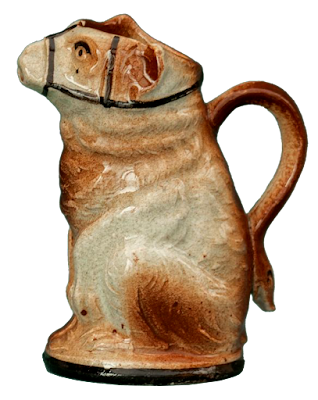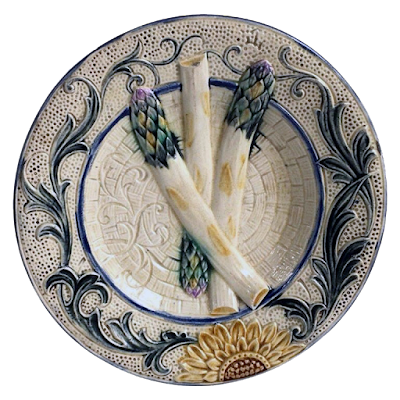If you've spent any time at all looking at majolica you've certainly come across the faience of the Wasmuël pottery of Belgium. Among the plentiful majolica potted in Europe Wasmuël majolica stands out; it is has a very specific look and color palette. Still, the story of Wasmuël is little known outside of Belgium.
The interest in majolica began to wane by 1907 and the company shifted more of its production to more modern wares. The period from 1880 to 1914 is the source for the majority of majolica we associate with Wasmuël today.
Decline
 |
| The pottery at Wasmuël with its large domed kilns |
History
The story of the faience factory in Wasmuël begins with potter Isidore Paulus in 1834. Paulus was the former manager of the pottery factory at Onnaing. He purchased land in the Belgian city of Wasmuël and built the pottery for the production of white glazed utility pottery and earthenware for sanitary use. With the introduction of majolica glazes in the 1850's Paulus began experimenting with majolica and solid colored earthenware. Soon he was incorporating majolica decorative wares into his line.
Upon Paulus's death in 1878 Jean-Pierre Mouzin who already operated the potteries at Nimy-les-Mons and Onnaing, gained control of the pottery and left it to be managed by his son Auguste Mouzin who expanded the pottery with the intention of exporting his faience to Great Britain and France where he saw a market for it. By 1880 a large percentage of the company's output had been converted to the production of decorative majolica for home use. Mouzin's son-in-law and successor Eugène Meyer and later his son Henri continued the production of faience in specialty and decorative products like asparagus sets and jardinières.
Upon Paulus's death in 1878 Jean-Pierre Mouzin who already operated the potteries at Nimy-les-Mons and Onnaing, gained control of the pottery and left it to be managed by his son Auguste Mouzin who expanded the pottery with the intention of exporting his faience to Great Britain and France where he saw a market for it. By 1880 a large percentage of the company's output had been converted to the production of decorative majolica for home use. Mouzin's son-in-law and successor Eugène Meyer and later his son Henri continued the production of faience in specialty and decorative products like asparagus sets and jardinières.
Factory at Wasmuẽl
The interest in majolica began to wane by 1907 and the company shifted more of its production to more modern wares. The period from 1880 to 1914 is the source for the majority of majolica we associate with Wasmuël today.
Auguste Mouzin
Wasmuẽl tribute plate to Henri Meyer
Workers at Wasmuẽl factory
Workers at Wasmuẽl factory
Painters at Wasmuẽl
Workers at Wasmuẽl molding room
After the end of World War I the pottery passed through a succession of managers. Majolica production continued on a limited basis until the beginning of World War II when production at the pottery slowed to a trickle. In 1951 financial problems caused the pottery to close. In 1952 the company was liquidated and the pottery demolished.
Marks
Marks
Wasmuël majolica is easily found today but not necessarily easy to recognize for the novice. The vast majority of Wasmuël majolica was not marked aside from a decorator's mark on the reverse; later pieces bear one of several ink marks.
As we mentioned earlier the company's glazes have a very specific color palate and look. With practice one can learn to recognize the glaze colors that distinguish the ware of this pottery from those of other European potteries.
I should mention that there was considerable overlap between the managers of the pottery at Onnaing and the pottery at Wasmuël so there is a certain similarity to the glazes of the two potteries.
Let's take a look at some of the ware.
The variety is enormous; the quality is fine. There is wit and charm in the work much in the French tradition of whimsy. One can't really say it is an elegantly designed majolica but it fits in very well with the country French market for which it is intended. Prices are generally quite reasonable too, which makes it a good choice for those on a limited budget.
As we mentioned earlier the company's glazes have a very specific color palate and look. With practice one can learn to recognize the glaze colors that distinguish the ware of this pottery from those of other European potteries.
I should mention that there was considerable overlap between the managers of the pottery at Onnaing and the pottery at Wasmuël so there is a certain similarity to the glazes of the two potteries.
Let's take a look at some of the ware.
Wasmuël majolica tiered server
Wasmuël Bonjour Wallon majolica jug
Signed Thurner
Majolica match striker
Unusual Wasmuël majolica chestnut dish
Wasmuël majolica peacock vase
Humidor
Majolica wall pocket
Wasmuël majolica oyster plate
Wasmuël majolica oyster plate
Wasmuël majolica egg dish
Wasmuël majolica goat pitcher
Wasmuël majolica asparagus plate
Wasmuël majolica umbrella stand
Wasmuël majolica goose or duck decanter. Signed F. Thurner
Wasmuël majolica boar match striker












































































No comments:
Post a Comment